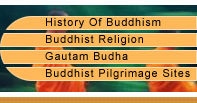Buddhism is known throughout the world for promoting the technique of meditation. Infact, meditation is considered to be one of the basic elements that make up Buddhism. It is deemed to be one of the essential practices in the path to enlightenment. In Buddhist tradition, each and every meditation technique is explained in detail. Meditation was adopted even by Lord Buddha Himself and the records of His own experience serve as the guidelines for those wishing to follow in His footsteps.
In meditation, practice is more important than the mere theoretical knowledge about its techniques. In this beginner guide on Buddhist meditation, we will tell you about the two basic techniques that Buddhists uphold.
Samatha
The first method is known as Samatha, which literally means peace or tranquility. This method is undertaken with initially one purpose in mind, concentration of the mind. The student is required to choose from forty subjects, including the ten kasinas (like, different colored discs, light such as a candle flame, water, etc) and a range of bodily decay (like a rotting corpse). A technique that is usually followed is anapanasati, mindfulness of breathing.
In this, a person calms both his body as well as his mind by focusing on his breathing. It is believed that as a person concentrates his mind on one particular aspect, the five major hindrances of his life, namely ill-will, sensual desire, anxiety, sloth and doubt, will cease to exist, even if on a temporary basis. The person who meditates then goes to the states of great happiness and rapture, known as jhanas. However, still he does not attain enlightenment.
Vipassana
The second method is known as Vipassana, literally meaning insight. Under this method, a person tries to see things as they actually exist. He tries to free his mind form aversions, which may affect his rational judgment. In other words, it insists on accepting the truth of what you are doing. If you are sitting, you should know that you are sitting and when you are standing, you should know that you are standing. This is the first state of Vipassana, known as bare awareness.
However, at the same time one has to have insight into the three marks of existence, which lie beneath all phenomena. These marks include suffering (dukkha); not-self (anatta) and impermanence (anicca). The technique of breathing meditation forms a part of Vipassana also. However, this method, unlike Samatha, can help you achieve the ultimate goal of enlightenment.
A Combination of the Two
Many a times, a combination of both Samatha and Vipassana is used. In the initial stages of meditation, a person makes use of Samatha. With time he gains the art of concentration and after this has been achieved, he moves towards Vipassana.
This article provides information about Buddhist/Buddhism meditation. Check out the Buddhist meditation techniques for beginners.
Buddhist Temples: Buddhism Facts: Buddhist Meditation




